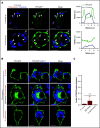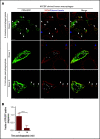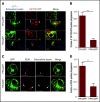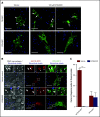Rapid removal of phagosomal ferroportin in macrophages contributes to nutritional immunity
- PMID: 33496744
- PMCID: PMC7839378
- DOI: 10.1182/bloodadvances.2020002833
Rapid removal of phagosomal ferroportin in macrophages contributes to nutritional immunity
Abstract
Nutrient sequestration is an essential facet of host innate immunity. Macrophages play a critical role in controlling iron availability through expression of the iron transport protein ferroportin (FPN), which extrudes iron from the cytoplasm to the extracellular milieu. During phagocytosis, the limiting phagosomal membrane, which derives from the plasmalemma, can be decorated with FPN and, if functional, will move iron from the cytosol into the phagosome lumen. This serves to feed iron to phagocytosed microbes and would be counterproductive to the many other known host mechanisms working to starve microbes of this essential metal. To understand how FPN is regulated during phagocytosis, we expressed FPN as a green fluorescent protein-fusion protein in macrophages and monitored its localization during uptake of various phagocytic targets, including Staphylococcus aureus, Salmonella enterica serovar Typhimurium, human erythrocytes, and immunoglobulin G opsonized latex beads. We find that FPN is rapidly removed, independently of Vps34 and PI(3)P, from early phagosomes and does not follow recycling pathways that regulate transferrin receptor recycling. Live-cell video microscopy showed that FPN movement on the phagosome is dynamic, with punctate and tubular structures forming before FPN is trafficked back to the plasmalemma. N-ethylmaleimide-sensitive factor, which disrupts soluble NSF attachment protein receptor (SNARE)-mediated membrane fusion and trafficking, prevented FPN removal from the phagosome. Our data support the hypothesis that removal of FPN from the limiting phagosomal membrane will, at the cellular level, ensure that iron cannot be pumped into phagosomes. We propose this as yet another mechanism of host nutritional immunity to subvert microbial growth.
© 2021 by The American Society of Hematology.
Conflict of interest statement
Conflict-of-interest disclosure: The authors declare no competing financial interests.
Figures








Similar articles
-
Iron Availability in Tissue Microenvironment: The Key Role of Ferroportin.Int J Mol Sci. 2021 Mar 15;22(6):2986. doi: 10.3390/ijms22062986. Int J Mol Sci. 2021. PMID: 33804198 Free PMC article. Review.
-
The myotubularin MTMR4 regulates phagosomal phosphatidylinositol 3-phosphate turnover and phagocytosis.J Biol Chem. 2019 Nov 8;294(45):16684-16697. doi: 10.1074/jbc.RA119.009133. Epub 2019 Sep 22. J Biol Chem. 2019. PMID: 31543504 Free PMC article.
-
Role of phosphatidylinositol 3-kinase and Rab5 effectors in phagosomal biogenesis and mycobacterial phagosome maturation arrest.J Cell Biol. 2001 Aug 6;154(3):631-44. doi: 10.1083/jcb.200106049. J Cell Biol. 2001. PMID: 11489920 Free PMC article.
-
Live Salmonella recruits N-ethylmaleimide-sensitive fusion protein on phagosomal membrane and promotes fusion with early endosome.J Cell Biol. 2000 Feb 21;148(4):741-53. doi: 10.1083/jcb.148.4.741. J Cell Biol. 2000. PMID: 10684255 Free PMC article.
-
Iron and innate antimicrobial immunity-Depriving the pathogen, defending the host.J Trace Elem Med Biol. 2018 Jul;48:118-133. doi: 10.1016/j.jtemb.2018.03.007. Epub 2018 Mar 10. J Trace Elem Med Biol. 2018. PMID: 29773170 Review.
Cited by
-
Severe anaemia, iron deficiency, and susceptibility to invasive bacterial infections.Wellcome Open Res. 2023 Feb 2;8:48. doi: 10.12688/wellcomeopenres.18829.1. eCollection 2023. Wellcome Open Res. 2023. PMID: 37600584 Free PMC article. Review.
-
Iron, Copper, and Zinc Homeostasis in the Battle between Macrophage and Mycobacterium Tuberculosis.Curr Med Chem. 2025;32(16):3155-3168. doi: 10.2174/0109298673283407231225140659. Curr Med Chem. 2025. PMID: 38231073 Review.
-
Manipulation of host phagocytosis by fungal pathogens and therapeutic opportunities.Nat Microbiol. 2024 Sep;9(9):2216-2231. doi: 10.1038/s41564-024-01780-0. Epub 2024 Aug 26. Nat Microbiol. 2024. PMID: 39187614 Review.
-
Inducible antibacterial responses in macrophages.Nat Rev Immunol. 2025 Feb;25(2):92-107. doi: 10.1038/s41577-024-01080-y. Epub 2024 Sep 18. Nat Rev Immunol. 2025. PMID: 39294278 Review.
-
Iron Availability in Tissue Microenvironment: The Key Role of Ferroportin.Int J Mol Sci. 2021 Mar 15;22(6):2986. doi: 10.3390/ijms22062986. Int J Mol Sci. 2021. PMID: 33804198 Free PMC article. Review.
References
-
- Weinberg ED. Iron and susceptibility to infectious disease. Science. 1974;184(4140):952-956. - PubMed
-
- Jabado N, Jankowski A, Dougaparsad S, Picard V, Grinstein S, Gros P. Natural resistance to intracellular infections: natural resistance-associated macrophage protein 1 (Nramp1) functions as a pH-dependent manganese transporter at the phagosomal membrane. J Exp Med. 2000;192(9):1237-1248. - PMC - PubMed
Publication types
MeSH terms
Substances
Grants and funding
LinkOut - more resources
Full Text Sources
Other Literature Sources
Research Materials
Miscellaneous

